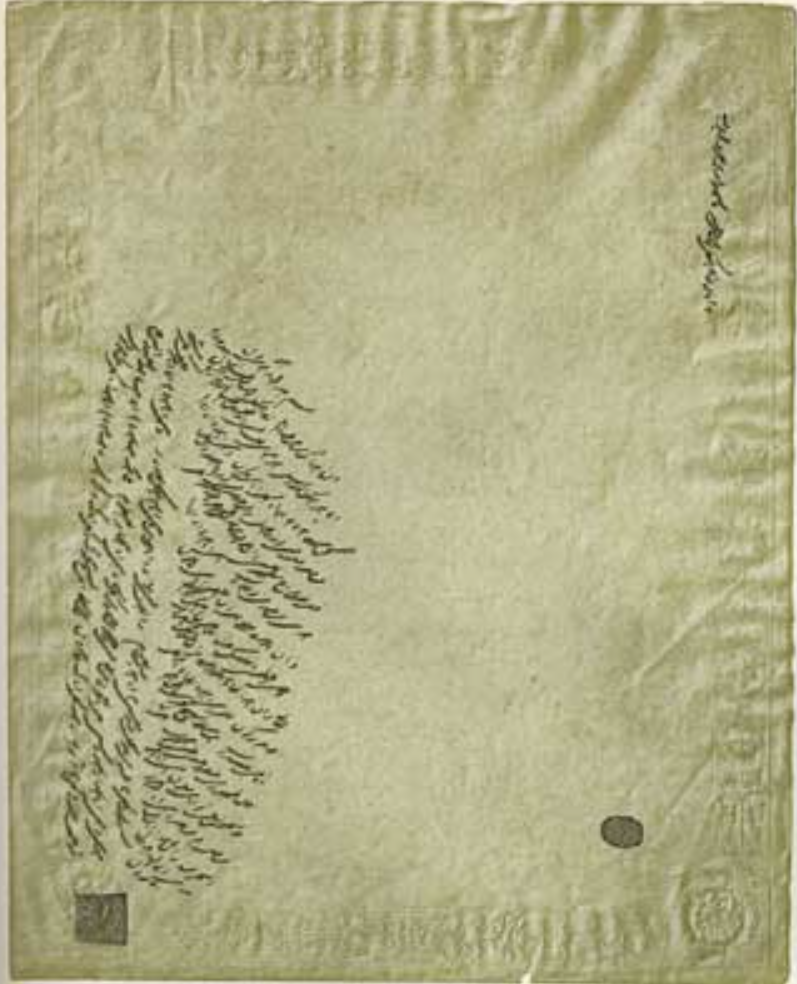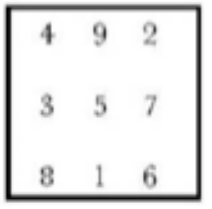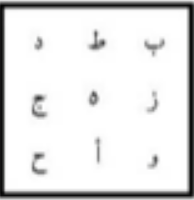
The Tablet of the Bab to the 18th Letter of the Living, Quddus -
Facsimile text from Muhammad Zarandi, Nabil-i A`zam, Tarikh/ Shoghi Effendi, The Dawn-Breakers (1st ed. 1932)
The Tablet to the Eighteenth Letter of the Living,
Muhammad `Ali Bārfurushi, Quddus (the Most Holy) (d. Bārfurush/Babol, 1849).
Introduction and Translation Stephen Lambden, UC Merced.
In Progress Last updated 13-10-2020
This brief Arabic Letter/Tablet reproduced above and translated below was addressed to Muhammad `Ali Barfurushi, entitled Quddus (the Most Holy) (b. Bārfurush c. 1328/1822 - d. near Barfurush-Babol, 23rd Jumadi II 1265 / 16 May 1849), the most important, most lofty and last (18th) of the elevated eighteen disciples of the Bab known as the Ḥurūf al-Ḥayy, the `Letters of the Living' (Ar. Hayy = H+Y = 10+8 = 18). This letter or Tablet to Quddus as a `Letter of the Living', opens with the standard (in Babi-Baha'i and other writimgs) "Huwa" indicating "He is God" and has a brief, introductory prolegomenon stating that it was revealed by the Bab for the Haykal - Temple/Person of the Eighteenth `Letter of the Living, An additional line refers to God as One Mighty or Noble (al-`azīz) as well as One Fearful, Feared or perhaps Terrorizing; alternatively, One Ascetic/ Monastic (marhūb) cf. Rahab = the Monk.
Lambden Beta Translation -
Last updated 25-09-2020
This is that which We revealed for the Eighteenth Temple [Letter of the Living = Quddus]. So bear thou witness that He is the Mighty [Noble] (al-`azīz), the Fearful-Terrorizing / Ascetic-Monastic] (marhūb).
He is [God]
In the name of God, the Most Eternal, the Pre-Eternal
(bismi’llah al-abad al-izāl).
[I]
This is a book (kitāb) [letter] from the letter al-thā’ 1 [= thamarah = the Fruit = the Bāb] unto the 18th Temple (haykal) [= Muhammad `Alī, Quddūs, the Most Holy]. I bear witness that He, no God is there except Him, the King (al-malik), the Most Holy (al-quddūs). He is the One Who commissioned among the Persians a Youth [two youths] (al-`ajamiyyīn ṣabiyy an) [= the Bab / Quddus] to the end that He might fill the pillars of all things (arkān kulli shay’) with [the cry] “Verily He, no God is there except I myself" for all should be aware of Myself. And I verily, I am God! (innani anā Allāh) no God is there except I myself. This before any before relative to the very essences ["atoms"] of Antecedence [“Beforeness”] (min qabl qabl fī dharrat al-qabl) as well as after the after within the very essences ["atoms"] of Futurity [“Afterwards”] (min ba`da ba`da fī dharrat al-ba`da).
[II]
`Alī before the Quadruple Configuration [= M H M D = Muḥammad] (ḥarf al-ru`bā’ = Muhammad > `Alī Muhammad = the Bāb) is the Manifestation of Myself (maẓhar nafsī) while the Eighteenth Letter (of the Living = Quddūs) among the Letters [of the Living] is [even as] Mine Own Self (li-nafsihi). At My Command, as a result of My Command, do all derive existence! I, verily am God, no God is there except I Myself. Whatsoever is other than Me, is My creation.
[III]
Say: O my creation! Ye shall all fear Me, My Divine Reality (ḥaqqī), My Omnipotence (`aẓimatī)! I did not create thee as a mere plaything (`abathan). He did not instruct thee, nor did I commission thee, save for the Day of the Encounter (liqa') with Me! This is the Meeting with the Manifestation of Mine own Logos-Self (liqā’ maẓhar nafsī) [the Bab]. But for a very few (qalīl an) among you, there shall be neither understanding nor comprehension!
[IV]
Say: I Indeed am God! No God is there except I myself and all should direct themelves towards Me! There is no single thing but that it should offer glorification (s-b-ḥ) through my laudation (ḥ-m-d) yet shall these realities at the moment of my theophany [manifestation] (ẓuhūr) by virtue of the manifestation of Myself (maẓhar nafsihi), remain entirely veiled therefrom.
[V]
Say: Nothing at all should remain veiled for all should be show piety before [fear] Me since I was thy Lord aforetime as well as in the hereafter. I Indeed, I am God, the Mighty, the Beloved (al-`azīz al-maḥbūb)!
[VI]
This book (kitāb) [letter, Tablet] contains verses (al-āyāt) from Myself unto the Letter thā’ of Eternaled Pre-Eternity [= thamarah al-azal al-īzūl) [sic.] to the end that all may bear witness that he [Quddus] is My servant (`abdī). I [the Bab] divulged My glory (tajallyyat) unto Him through Mine own Logos-Self/Myself (nafsī) for there is no Deity except I Myself, God, the Help in Peril, the Self-Subsisting (al-muhayymīn al-qayyūm). I did cast into his [Quddus'] inmost heart (fū’ād) [such] expository verses (āyāt bayyināt), as, “I [Quddus] indeed am God the Ruler (al-malik) Almighty [sic] (al-qaydūr), I indeed am God, no God is there except I Myself. I created everything through My Command (bi-amrī) for I am indeed the Foreordainer (al-qaddār), the Sanctified (al-qaydūs)!
[VII]
Say: Nothing can compromize mine inimitability within the Divine Realm (lāhūt), within the Omnipotent Domain (jabarūt) of everything (kull shay’). I [the Bab], verily, am the Omnipotent Ordainer (al-Jabbār), the Supremely Great [sic.](al-`ayẓūm). Yet of a certainty (balā)! Thou [Quddūs] art indeed God, no God is there except Thee, the Supremely Powerful Lord (rabb al-muqtadir), the One of Talismanic Potency (al-badūḥ = 2-4-6-8)! Thou createth whatsoever thou willeth and thou will create whatsoever thou desireth. No God is there except thee. All should be worshipful of thee. There exists nothing but that it should offer glorification through the Praise of thyself. All should be especially mindful of thee. Thou art indeed God! No God is there except Thee. Before thee we are all in a state of certainty!
[Sealed] His servant (`abd), the Remembrance (al-dhikr).
♦
Select Expository Notes
This Translation is based on the an original facsimilie in the handwriting of the Bab published by Shoghi Effendi in his recreation of Nabil-i Zarandi's unpublished multi-volume Tarikh re-entitled The Dawn-Breakers... (1st ed. 1932). I have also had the befefit of consulting an Arabic transcription of the Dawn-Breakers facsimilie by Muhammad Afnan (d. Canada, 201X) as well as the Arabic text deriving from `Abd al-Hamid Ishrāq Khavarī and Sa`īd Raḍavi as printed in Sar Gudhasht wa āthār-i Jinab-i Quddūs (Intishārāt-i `Ādil, 2016) page 8 by Hooshmand Dehqān. See above.
Paragraph [I]
Note 1 = the thamarah (Fruit) is here the Fruit of the Tree of Reality, namely the Bāb] unto the 18th Temple (haykal), namely the Letter of the Living Muhammad `Alī, Quddūs (the Most Holy). The Bab himself uses the title al-thamarah as did Mirza Yahya Subh-i Azal.
Paragraph [I] - Two Alternative translations.
A. Trans. 1 "He is the One Who commissioned [raised up] two youthful Persians (al-`ajamiyyayn ṣabiyy an) to the end that He might fill the pillars of all things (arkān kulli shay’) with [the cry] “Verily He, no God is there except I myself for all should be aware of Myself. And I verily, I am God! (innani anā Allāh) no God is there except I myself.
B. Trans. 2 "He is the One Who commissioned [raised up] from among the Persians (al-`ajamiyyin ṣabiyy an), a Youth [the Bab = Quddus] to the end that He might fill the pillars of all things (arkān kulli shay’) with [the cry] “Verily He, no God is there except I myself [“We two” /“Us both”] for all should be aware of Myself. And I verily, I am God! (innani anā Allāh) no God is there except I myself [Us two].
The following line has a close connection with some sentences in the Kitāb al-ṭāwāsīn [ṭā-wa-sin\ ('The Books of the Ta' ("T") and the Sin ("S")' of Ḥusayn bin Manṣūr al-Ḥallāj' (b. al-Bayḍā', Fars, Persia, c.244/858- d. executed Baghdad, 309/922), famous for his theophanic cry أنا الحق Anā al-Ḥaqq "I am The Truth [God]":
"This before any before relative to the very essences ["atoms"] of Antecedence [“Beforeness”] (min qabl qabl fī dharrat al-qabl) as well as after the after within the very essences ["atoms"] of Futurity [“Afterwards”] (min ba`da ba`da fī dharrat al-ba`da).
Add refs. Jawid Mojaddedi `ḤALLĀJ, ABU’L-MOḠIṮ ḤOSAYN b. Manṣur b. Maḥammā Bayżāwi' EIr, Vol. XI, Fasc. 6, pp. 589-592/ https://iranicaonline.org/articles/hallaj-1
Louis Massignon (1883-1962). La Passion deHusayn Ibn Mansûr al-Hallâj 4 vols. Paris, 2nd ed., 1975.
Paragraph [VII] The One of Talismanic Potency (al-badūḥ = 2-4-6-8)!
Say: Nothing can compromize mine inimitability within the Divine Realm (lāhūt), within the Omnipotent Domain (jabarūt) of everything (kull shay’). I [the Bab], verily, am the Omnipotent Ordainer (al-Jabbār), the Supremely Great [sic.](al-`ayẓūm). Yet of a certainty (balā)! Thou [Quddūs] art indeed God, no God is there except Thee, the Supremely Powerful Lord (rabb al-muqtadir), the Seal of Talismanic Potency (al-badūḥ = 2-4-6-8)!
بدوح Badūḥ / Budūḥ, the Abjad Letters 2-4-6-8, A potent occult neologism used in forming a threefold magic square.



Badūḥ : the Threefold Magic Square(s) and another Fourfold talismanic inscription.
The Islamic Background
The word badūḥ is derived from the abjad succession of the first four even numbers/letters. It follows the well-known abjad system of letter-number configuration. See EIr. Abjad. In Islamic talismanry and associated magic squares (waqf al-a`dad) badūḥ has been associated with Adam or the first couple and with the "seal" of the Israelite king Solomon (fl. 10th cent BCE). It can allegedly actualize (among other things) the power of the speedy communication of data or messages, be of benefit at childbirth. and
Jabir ibn Hayyan
The Rasa'il Ikhwan al-safa' (Treatises of the Brethren of Purity)
In his Munqidh min al- Dalal (The Deliverance from Error), `Abd al-Hāmid al-Ghazali (1058–1111) refers to two threeold (3x3) magic squares (see the two image above) yielding fifteen in all directions. They were reckoned, when "inscribed on two pieces of cloth untouched by water" to be useful in treating cases of difficult childbirth.
A work is attributed to Abd al-Hāmid al-Ghazali (1058–1111) entitled الاوفاق للغزالى
Abraham ben Meir ibn Ezra (c. 1090-1167) Hebrew and Arabic
al-Būnī = البوني = `Abu al-`Abbas Ahmad ibn `Ali ibn Yūsuf al-Qurayshī, Muḥyī al-Dīn al-Būnī (d. Cairo, c. 622/1225 or slightly later)
An Islamic theologian, mystic and magician, Ahmad ibn `Alī al-Būnī. wrote around 40 Arabic books on Islamic esoterica and related subjects. He had a special facility with the theology of occult or talismanic configurations of the Names of God and number-letter magic squares. Most of his often complex work remains unedited, unstudied and unpublished, save for a few more or less non-critical editions. His Kitāb shams al-ma`arif wa latā'if al-awārif ("The Book of the Sun of Gnosis and the Subtleties of Elevated things").... exists in several recensions of different lengths.
The intricacies of al-Būnī's Shams al-ma`ārif were known to Shaykh Ahmad al-Ahsā'ī. He answered some difficult questions about aspects of it in his erudite al-Risāla al-Rashtiyya (1226/1811 see Jawāmi` al-kilam 1/2:63-114; lbrāhimī, Fihrist, No. 104 p,260f; Momen, BSBM 1: 113). There is little doubt that theologically profound aspects of the writings of al-Būnī directly or indirectly influenced the architects of what became Shaykhism which the Bāb may have come to know or have studied in his youth. It will be seen below that al-Rashtī's commentary on the graphic form of the ism al-a'zam appears to have been influenced by the comments of al-Būnī in the Shams al-ma'ārif and elsewhere.
See further
Macdonald, D. B., "Badūḥ", in: Encyclopaedia of Islam, 2nd ed. Edited by P. Bearman, et al.
T. Canaan, The decipherment of Arabic talismans, in Berytus, iv (1937), 100 ff.
H. Hermelink, Arabische magische Quadrates mit 25 Zellen, in Sudhojj"s Archiv far Geschichte
der Medizin, xliii (1959), 351-4.
L. Fischer, Zur Deutung des magischen Quadrates in Durers MELENCOLIA I, in ZDMG, ciii ( 1953), 308-14
Denis MacEoin, ‘Nineteenth-Century Babi Talismans’, Studia Iranica 14:1 (1985), pp.77-98.
Quddus al-Badūḥ
In this Tablet to Quddus, this 18th Letter of the Living is intimately associated with the Bab to the degree that he shares or mirrors his subordinate Divinity. For the Bab, Quddus is especially related to the Divine Power which is concentrated in his being as the centrally potent Talismanic Seal. He is even as a lofty transformative Seal of Talismanic Potency. Badūḥ (B+D+W+H = abjad 2+4+6+8) commences with the generative letter B (abjad 2) with its Nuqta (Point) which is the genesis of sacred writ, the fourfold all-encompassing (cf. 4 elements; 4 directions, etc) letter D (abjad 4), the last letter of the fourfold name Muhammad (M+H+M+D), the six related (3x2 = 6) letter W (abjad 6) and the letter H (abjad 8) which is the second letter of the name Muhammad and the first letter if the Name of God al-hayy (the Living One). In the threefold magic square configuration (see above) the nine letter-numbers add up to fifteen whether read vertically, horizontally or diagonally. Fiftteen is the numerical value of Hawa or Eve (h+w+a = 8+6+1 = 15). Perhaps the Bab and Quddus could be viewed as the eschatological Mother (Eve = 15) and Father (Adam = 45 = 15x3) of the new Babi era or gnosis. Note also that the name of the Bab and Quddus form a kind of syzygy `Ali+Muhammad = the Bab and Muhammad+`Ali = Quddus.
The Elevated station of Muhammad `Ali Barfarushi, Quddus.
The Bab - Ziyarat-Namah for Quddus
This Arabic visitation Tablet commences with the new, post-Qur'anic apophatic Basmala of the Bab : "In the Name of God, the Most Inaccessible (al-amna`), the Most Holy (al-aqdas)" followed by a threefold repetition of the title of Mirza Muhammad `Ali Batfurushi, Quddus (the Most Holy), namely, Quddus. Quddus. Quddus. It continues as follows,
"May the Glory (al-baha') from God, no God is there save Him, be upon thine inmost heart (fu'ad) and upon the inmost heart (fu'ad) of whomsoever is of thine inmost heart (fu'ad); as well as upon thy spirit (ruh) and upon the spirit (ruh) of whomsoever is of thy spirit (ruh); and likewise may it be upon thy self (nafs) and whomsoever is of thy self (nafs) and upon thy body (jism) and whomsoever is of thy body (jism). Then, furthermore may the Divine Bounty (al-`ala') from God be upon thine inmost heart (fu'ad) and upon the inmost heart (fu'ad) of whomsoever was created from the Light of thy Glorification (tasbih) ...
The Divinity of Quddus in the Kitab-i Panj Sha`n (Book of the Five Modes).
The Kitab-i panj sha`n (Book of the Five Modes) of the Bab is a fairly lengthy (400-500) Arabic and Persian work named after the fives modes, categories or divisions of revelation into which it is divided ([1] āyāt, revealed Arabic verses, [2] munājāt = devotional revelations, [3] khuṭbas = literary orations (very loosely "sermons") or alternatively ṣuwar ʿilmiyya = surahs expressive of divine knowledge), [4] tafsīr (scriptural commentary), and [5] fārsī = Persian revelations (see P. Bayan III:17; VI:1; IX:2, etc). It was completed over a seventeen-day period (Jumādā I, 1266/March-April, 1850) and has (in some recensions). It has XII major pentadic divisions dedicated to key disciples of the Bab, some of them hurufat al-hayy (Letters of the Living). It is in the fourth Arabic tafsir (commentary) section within its eighth division (VIII) - which is dedicated to Mulla Shaykh `Ali Turshizi (d. 1852), entitled `Azim (the Mighty) - that we find clear testimony to the elevated divine status of Quddus (see Azali, ed. 272-282). Therein we read:
So observe how it was that he came, his Eschatological Associate (sahib) and his Garment (qamits) and recite [say] : Quddūs! Quddūs! Quddūs! Quddūs! Then bear thou witness that naught is seen in the inner dimension (al-batin) thereof except the outer dimension (al-zahir) while naught is seen in the outer dimension (al-zahir) except the inner dimension (al-zahir). In the beginning (al-awwal) naught is seen except the end (al-akhir) while in the end (al-akhir) naught is seen except the beginning (al-awwal). Yea Indeed! The Name of God the al-Akhir (the Ultimate-End-Last = a title of Quddūs) shone forth, radiated, flashed lightening, and shed brilliance! So Blessed be whomsoever seeth naught therein except God! And there doth not circle around him [Quddūs] save whatsoever is beloved of God; relative, that is, to His Own Logos-Self (nafs)... (KPS. IX.4 p. 280).
The Baha'-Allah - Ziyarat-Namah for Quddus
Baha'-Allah in the Lawh-i kull al-ta`am, c. 1854-6 :
The modern Baha'i position regarding Quddus as expressed by Shoghi Effendi and others:
God Passes By : XX -Add here ...
"Regarding the station of Quddus, he should by no means be considered having had the station of a Prophet. His station was no doubt a very exalted one, and far above that of any of the Letters of the Living, including the first Letter, Mulla Husayn. Quddus reflected more than any of the disciples of the Bab the light of His teaching." (11 November 1936, written on behalf of Shoghi Effendi to an individual believer).
"It may be helpful to consider that in the Dispensation of the Bab, Quddus is referred to as the "Last Point", and the "Last Name of God", is identified, as pointed out in God Passes By, with one of the "Messengers charged with imposture" mentioned in the Qur'an, and is one of the "two witnesses" into whom "the spirit of life from God" must enter, as attested by 'Abdu'l-Baha in Some Answered Questions, yet, despite these sublime stations, he is not regarded as an independent Manifestation of God." (24 August 1975, written on behalf of the Universal House of Justice to an individual believer)
